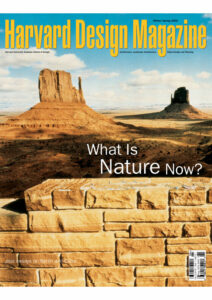Letters
As one of your appreciative readers and a subscriber to Harvard Design Magazine, I was very pleased that you chose to review my book, The Final Testament of Père Corbu, in your Fall 1999 issue, along with Adolf Max Vogt’s Le Corbusier, the Noble Savage. Together they frame the architect’s life, as alpha and omega.
The Final Testament of Père Corbu
There were certain misconceptions in Professor Daniel Naegele’s review, however, that I would like to set straight, and I hope your journal can find the space to print this partial explanation. First, the reviewer’s insistence that Le Corbusier’s Mise au point was “mostly unedited” and “considered incomplete”: at several points in my Introduction I stress, with corroborating testimony from Jean Petit, that Le Corbusier “worked over the definitive manuscript in July 1965” (a date that appears on the text as well, in Le Corbusier’s own hand). This history of this document is indeed complex, but there is no doubt that Petit’s publication and mine are one and the same, based on the final version prepared for publication by Le Corbusier before his untimely death (fn. 15, 158, and in my text, 6–8).
Then there is the issue of the “brevity of the text itself,” which Naegele mentions as “the most obvious obstacle to any publication.” I could not agree more. In addition, Fondation Le Corbusier in Paris withheld the right to publish a translation of Mise au point as a freestanding document, urging me instead to embed it in a book of my own. For this very reason I resolved to incorporate Le Corbusier’s tiny 18-page text into my book, which was designed not as a translation primarily—although one was provided—but as a interpretation of the final years of Le Corbusier’s life. This problem of genre was compounded when Yale University Press mistakenly marketed the book as “by” Le Corbusier, both on the jacket and the title page, giving the impression that the architect somehow posthumously recognized Mise au point as his epitaph and annotated it from the grave. Furthermore, the subtitle was to read: “A Translation and Interpretation of Le Corbusier’s Miseau point,” with myself listed as author. Had the title page and jacket not been altered at the last moment, both my role and Le Corbusier’s would have been clear.
For the above reasons, it was painful to read in Naegele’s review that the “lengthy introduction,” the heart of my book, he considers “unfortunate.” When “one arrives at Le Corbusier’s writing,” he writes, “it seems neither bitter nor broken, but refreshingly straightforward.” To enable that impression was precisely the rationale for placing my explanatory text before the translation. There, Le Corbusier’s bitterness is put into sympathetic context and, I hope, even dissolved through a discussion of his built and unbuilt oeuvre, the disappointing scarcity of commissions during his final decade, the death of his wife, interviews with her doctor, his final correspondence with clients and friends—all based on original research. Naegele welcomes the inclusion of the aging architect’s final interview (“The Final Year”) at the end of my book, and I agree that an “epilogue” should properly belong to the voice of the subject, not some commentator in competition with it. But it appears that Naegele did not get very far into the story provided in the lengthy Introduction. I would like to believe that his ungenerous verdict was based on a lack of familiarity with the genre of my book and its theses, not by a rejection of them.
Ivan Zaknic is Professor of Architecture at Lehigh University.
